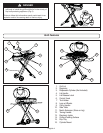Special offers from our partners!

Find Replacement BBQ Parts for 20,308 Models. Repair your BBQ today.

English-3
General Installation
Portable L.P. Gas Barbecue Cylinders
WARNING
Your new barbecue grill is equipped with a CGA # 600
regulator [B]. DO NOT attempt to connect this regulator
to any other disposable L.P. cylinder not equipped with a
mating CGA # 600 tting [E]. This grill may only be used
with the pressure regulator supplied with this unit, or
pressure regulators specied by Coleman for use with this
unit. Replacement regulators must only be those specied
by Coleman. (Fig. 1)
WARNING
This appliance is not to be installed in or on a recreational
vehicle and/or boat.
Follow these safety rules before each use:
1. A minimum clearance of 24 inches from the left, right,
back and bottom sides of the grill must be maintained
between the grill and any combustible construction such
as wood siding of a building.
2. Never locate the grill under an unprotected combustible
material or overhang.
3. Do not obstruct the ow of combustion and ventilation
air. Maintain a minimum clearance of 3 inches from the
back of the grill and non-combustible construction such
as a concrete or brick wall.
4. The grill should be level and not facing directly into the wind.
WARNING
A liquid propane tank, not connected for use with this gas
barbecue, shall not be stored in the vicinity of this or any
other appliance.
WARNING
r DO NOT attempt to adjust the regulator as this could
create a situation causing personal injury or prop-
erty damage.
WARNING
r NEVER place more than 20 pounds on a side table. DO
NOT lean on grill.
r NEVER use charcoal briquettes or lighter uid in a gas
grill.
r Grill is hot when in use; to avoid burns, DO NOT touch
any hot grill surface. Keep children and pets away from
hot grill.
r NEVER leave the grill unattended while it is in use.
r It is your responsibility to assemble, install, operate and
care for your gas grill properly.
r DO NOT use gas grill indoors.
r Under some circumstances, propane may lose the
distinctive odor that was added. Other strong odors may
hide or mask the odor of propane. Colds, allergies, sinus
congestion, and the use of tobacco, alcohol or drugs
may impair your ability to detect the odor of propane.
r Installation must conform with local codes or, in the
absence of local codes, with either the National Fuel Gas
Code, ANSI Z223.1/NFPA 54, Natural Gas and Propane
Installation Code, CSA B149.1, or Propane Storage and
Handling Code, CSA B149.2, as applicable.
r To check local codes, see your local L.P. gas dealer
or natural gas company listed in the Yellow Pages for
recommended installation procedures and regulations.
Connections must comply with local requirements and
are the sole responsibility of the person performing the
work.
Liqueed Petroleum gas (abbreviated L.P. gas or
propane), is highly ammable. It becomes liquid when
stored under high pressure inside a cylinder and vaporizes
when released. L.P. gas is heavier than air and tends to
collect in low areas. It is important that there are no leaking
connections on your gas grill that could cause a re or
explosion (see the section titled “LEAK TESTING”).
Portable LP gas grills require a fuel delivery system which
is comprised of a valve [A], a regulator [B] with vent hole [C],
an L.P. gas supply cylinder [D], (Fig. 1). Illustration in Fig. 1 is
for description purposes only.
Cylinder Specications
r All L.P. gas cylinders used with this appliance shall
be constructed and marked in accordance with the
Specications for L.P. Gas Cylinders of the U. S.
Department of Transportation (DOT) or the National
Standard of Canada, CAN/CSA-B339, Cylinders, Spheres
and Tubes for Transportation of Dangerous Goods; and
Commission, as applicable; and a cylinder connection
device compatible with the connection for outdoor cooking
appliances.
r Read labels on the L.P. Gas Supply Cylinder.
Fig. 1
A
C
B
D
E


















